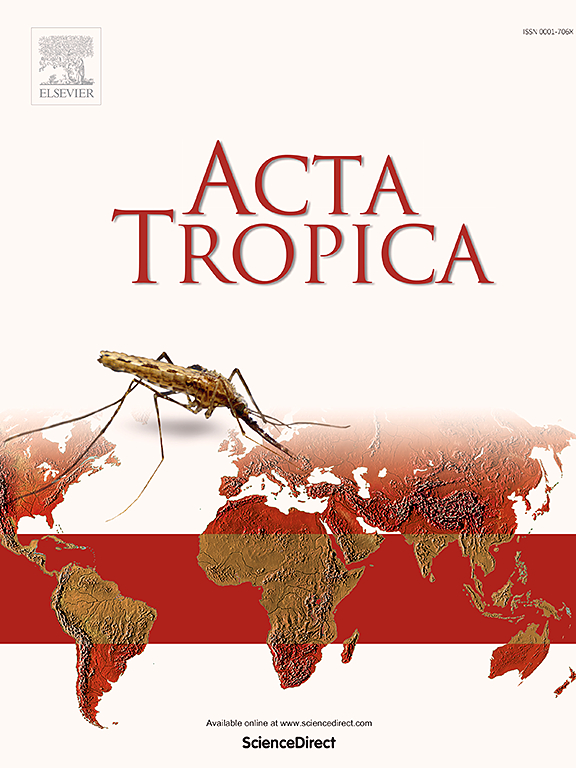Molecular genotyping of pyrethroid resistant mutations and their haplotypes in bed bug populations from Greece
IF 2.1
3区 医学
Q2 PARASITOLOGY
引用次数: 0
Abstract
The resurgence of bed bugs poses significant risks to public health and tourism-driven economies in Southern Europe, including Greece. Control efforts largely rely on pyrethroids; however, the widespread selection of knockdown resistance (kdr) mutations has compromised their effectiveness. Molecular monitoring is therefore essential for accurate species identification and resistance surveillance to support evidence-based pest management strategies. In this study, we analyzed bed bug populations collected from Athens, Thessaloniki, and Heraklion between 2021 and 2024. Species identification was performed via DNA barcoding of the cytochrome oxidase I (COI) gene, while kdr mutations in the voltage-gated sodium channel (VGSC) gene—specifically V419L, L925I, and I936F—were assessed to determine their frequencies and haplotype distributions. All specimens were identified as Cimex lectularius. The L925I mutation reached fixation (100 %) in Thessaloniki and Heraklion, while V419L was detected at frequencies of 30.00 % and 50.00 %, respectively; I936F was not detected in these populations. In Athens, L925I was highly prevalent (98.40 %), while V419L (5.27 %) and I936F (0.60 %) were detected at lower frequencies. Haplotype analysis revealed Haplotype B (L925I only) as the most common in Athens (91.20 %) and Thessaloniki (60.0 %), while Haplotype C (L925I + V419L) predominated in Heraklion (76.92 %). Additional haplotypes were identified in Athens, including Haplotype Bb (L925I + I936F), marking its first detection in Europe. These findings highlight the widespread presence of kdr mutations and underscore the urgent need for integrated pest management (IPM) strategies, incorporating resistance monitoring, alternative insecticides, and non-chemical control methods to mitigate the growing challenge of pyrethroid resistance in bed bugs.

希腊臭虫种群中拟除虫菊酯抗性突变及其单倍型的分子基因分型
臭虫的死灰复燃对南欧(包括希腊)的公共卫生和旅游业驱动型经济构成了重大风险。控制工作主要依靠拟除虫菊酯;然而,低敲抗性(kdr)突变的广泛选择削弱了它们的有效性。因此,分子监测对于准确的物种鉴定和耐药性监测至关重要,以支持循证害虫管理战略。在这项研究中,我们分析了2021年至2024年间从雅典、塞萨洛尼基和伊拉克利翁收集的臭虫种群。通过细胞色素氧化酶I (COI)基因的DNA条形码进行物种鉴定,同时评估电压门控钠通道(VGSC)基因中的kdr突变-特别是V419L, L925I和i936f -以确定其频率和单倍型分布。所有标本经鉴定均为白蚁。L925I突变在塞萨洛尼基和伊拉克利翁达到固定(100%),而V419L的检测频率分别为30.00%和50.00%;在这些人群中未检测到I936F。在雅典,L925I的检出率最高(98.40%),而V419L(5.27%)和I936F(0.60%)的检出率较低。单倍型分析显示,单倍型B (L925I + V419L)在雅典(91.20%)和塞萨洛尼基(60.0%)最常见,而单倍型C (L925I + V419L)在伊拉克利翁(76.92%)最常见。在雅典还发现了其他单倍型,包括单倍型Bb (L925I + I936F),这是该型在欧洲首次被发现。这些发现强调了kdr突变的广泛存在,并强调了综合虫害管理(IPM)策略的迫切需要,包括耐药性监测、替代杀虫剂和非化学控制方法,以减轻臭虫对拟除虫菊酯类杀虫剂耐药性日益严重的挑战。
本文章由计算机程序翻译,如有差异,请以英文原文为准。
求助全文
约1分钟内获得全文
求助全文
来源期刊

Acta tropica
医学-寄生虫学
CiteScore
5.40
自引率
11.10%
发文量
383
审稿时长
37 days
期刊介绍:
Acta Tropica, is an international journal on infectious diseases that covers public health sciences and biomedical research with particular emphasis on topics relevant to human and animal health in the tropics and the subtropics.
 求助内容:
求助内容: 应助结果提醒方式:
应助结果提醒方式:


